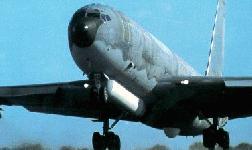

Posted on 03/21/2003 1:20:00 PM PST by green team 1999
Rising JSTARS High-Tech Radar Plane to Coordinate Gulf Ground War
By Paul Eng
March 20 — When it comes to fighting in Iraq, military planners and analysts anticipate fleets of jets dropping thousands of precision-guided bombs will produce a swift and decisive blow from the air.


Whether such massive air attacks in the opening days of the war will produce the desired "shock and awe" effect to break Iraqi resistance remains to be seen. But one thing is clear: Coalition ground forces will still have to enter Iraq to seize control of key areas and capture or kill Saddam Hussein and his inner circle.
Key to that effort will be a highly specialized plane that normally hangs well to the rear of the action — The Joint Surveillance Target Attack Radar System, or JSTARS.
The plane, developed by U.S. military specifically for coordinating massive ground attacks, is equipped with the latest computers, satellite and radio communications, and a sophisticated radar system.
JSTARS can identify and track moving targets on the ground and relay that information to ground commanders in front-line units and back at central command in Qatar and at the Pentagon.
Although the range of JSTARS' complex electronic radar system is still classified, military analysts like John Pike at GlobalSecurity.org speculate a JSTARS could safely pick out targets in Iraq while flying over the relative safety of Kuwaiti airspace.
"With the flat terrain over Iraq, you can see pretty far into Iraq and still be inside Kuwait," says Pike.
Lifting the Fog of War
The advantage JSTARS will give allied forces? To help manage the so-called "fog of war" — the uncertain circumstances and events that occur in any conflict, explains Martin Streetly, an editor with Jane's Electronic Missions Aircraft.
"Once you go over the start line, people get lost, things go wrong, people get confused," says Streetly.
And allied forces in Iraq will face additional uncertainties that could compound casualties and grind the advance toward Baghdad to a halt. Could Saddam's elite Republican Guard and Special Republican Guard units attack with chemical or biological weapons? Where are the mobile Scud launchers that could lob chemical attacks on Israel and ignite a larger-scale war? How formidable are the defenses around Baghdad?
But JSTARS' powerful radar could help commanders sift through some of these elements in near-real time.
For example, JSTARS' radar spots moving ground targets — including low-flying helicopters — using a process called Doppler shift. Computers in a JSTARS-equipped plane can tell its operators where and how fast the targets are going, information that can then be sent to the appropriate commanders through a secure digital data link.
God’s-Eye Views
"Imagine the Iraqis launch an armored thrust against the U.S. lines of advance," says Streetly. "JSTARS' [radar] can track that as it flies through the air hundreds of miles away. Combine that with data from other planes — video from Predators or space satellites — and suddenly you get a God's-eye view of the battlefield, which is what [commanders] want."
What's more, since JSTARS' radar isn't blinded by smoke, weather, or light conditions, and GlobalSecurity's Pike says the plane could be extremely useful in the attack against Baghdad itself.
"[Iraq] will try to blind the forces' smart bombs, to blind the optics," says Pike. "So you will use JSTARS to see through it."
The JSTARS has proven itself in previous battles. In fact, the entire "God's-eye" concept was first tested 12 years ago in Operation Desert Storm.
Back then, two prototype JSTARS had tracked a massive retreat of Iraqi armor from Kuwait City. By directing continuous and successful allied air attacks against the armor, the carnage would later become known as the "highway of death" — and seal the plane's reputation as an important tool in the U.S. arsenal.
Key But Limited Role?
While JSTARS' airborne surveillance of potential ground threats could be a decisive edge for allied forces, Pike does warn the plane is no magic bullet.
"One of the problems with JSTARS is it is an awful lot easier to detect moving vehicles than figure out if they are combatants or refugees or civilians," says Pike. "When the Iraqis light up the oil fires and JSTARS sees vehicles moving on the road, they won't know if it's an army convoy or refugees."
What's more, JSTARS will only detect moving ground targets, not forces already in place and stationary.
Still, that might not be as large a flaw for allied commanders.
for information and discusion only,not for profit etc,etc.
Disclaimer: Opinions posted on Free Republic are those of the individual posters and do not necessarily represent the opinion of Free Republic or its management. All materials posted herein are protected by copyright law and the exemption for fair use of copyrighted works.